Abstract
As silver nanoparticles (AgNPs) are used in a wide array of commercial products and can enter the human body through oral exposure, it is important to understand the fundamental physical and chemical processes leading to changes in nanoparticle size under the conditions of the gastrointestinal (GI) tract. Rapid AgNP growth was observed using nanoparticle tracking analysis with 30 s resolution over a period of 17 min in simulated gastric fluid (SGF) to explore rapid kinetics as a function of pH (SGF at pH 2, 3.5, 4.5 and 5), size (20 and 110 nm AgNPs), and nanoparticle coating (citrate and PVP). Growth was observed for 20 nm AgNP at each pH, decreasing in rate with increasing pH, with the kinetics shifting from second-order to first-order. The 110 nm AgNP showed growth at ≤3.5 pH, with no growth observed at higher pH. This behavior can be explained by the generation of Ag+ in acidic environments, which precipitates with Cl−, leading to particle growth and facilitating particle aggregation by decreasing their electrostatic repulsion in solution. These results highlight the need to further understand the importance of initial size, physicochemical properties, and kinetics of AgNPs after ingestion to assess potential toxicity.
Graphical abstract
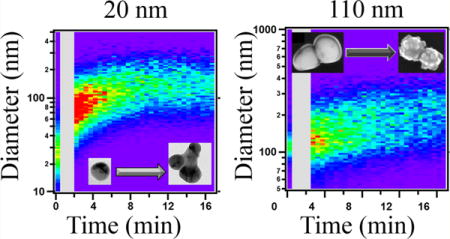
INTRODUCTION
Silver nanoparticles (AgNPs) are widely used as antimicrobial or delivery agents in consumer products such as clothing, food packaging, dietary supplements, and many others.1–3 As the usage of AgNPs has increased in recent years, there have been concerns regarding potential adverse health effects from exposure.4–12 Ingestion, whether intentional or not, is an important route of AgNP exposure; potential impacts of which have recently been reviewed.9 Significant health-related impacts appeared to only occur at high doses, with the lowest adverse effect levels ranging from 1 mg/kg body weight in mice to 125 mg/kg in rats. Reported high dose effects in these or other species include altered liver enzymes, altered blood properties, skin discoloration (argyria), vascular alterations, and immunological effects.9 Since these findings predominantly occur with high doses, a great deal of uncertainty remains as to the overall safety and effects of ingested AgNPs at more typical dose levels in the human body.5,8–10
A significant challenge when evaluating the health implications of AgNP exposure is the complex set of physical and chemical properties that nanoparticles have (shape, surface composition, crystal structure, stability, etc.) due to their size, which may vary depending on their environment.7,8,13–17 For example, there is a dramatic difference in the fraction of silver atoms available at the surface of AgNP for biochemical interactions, ranging for example, from ~15% of the total atoms for a 5 nm particle to less than 0.1% for a 100 nm particle.18 A higher percentage of surface atoms can lead to higher rates of dissolution,15,19,20 which can be calculated via the Ostwald–Freundlich relation for size dependent dissolution.20 In addition, silver from these AgNP may be present in the body as metallic silver (Ag0), ionic silver (Ag+), or silver chloride (AgCl), which makes the dynamics between the solution phase and particle phase important for understanding the overall behavior of ingested AgNP. AgCl has a particularly low solubility (1.92 × 10−4 g/100g H2O), which can lead to precipitation of the abundant chlorine ion (Cl−) content in the stomach with Ag+ after dissolution. As such, it is expected that even for particles of the same initial composition (Ag0), crystal structure, and environmental exposure, the surface-dependent processes that drive dissolution and aggregation will vary as a function of particle size, resulting in a distribution of silver between Ag0, Ag+, and AgCl (s) forms.21 Within the respiratory system, smaller AgNPs (i.e., 20 nm) lead to higher cellular toxicity and oxidative stress than larger AgNPs (i.e., 110 nm) because of the higher dissolution rate based on surface area as discussed above.22 Physicochemical properties of the AgNPs also play a role, particularly in the formation and subsequent behavior of the protein corona around the nanoparticles.23,24 The proteins of the corona may act as signals to trigger downstream biological responses in the body given that the surface protein is first encountered by the body’s cells.25 As a result of the complexity arising from size, structure, and chemically mediated biological interactions, it is critical to fully understand the physicochemical properties and kinetics of ingested AgNPs if causal relationships with biological responses are to be elucidated.
The potential for AgNPs to have toxic effects after oral ingestion is modulated by the different environments, including varying acidity, salt content, and biological media, to which the particles are exposed as they pass through the gastrointestinal (GI) tract.9 Several prior studies have examined AgNP dissolution and aggregation in acidic environmental and biological media,7,14,20,21,26–31 but few have focused on the kinetics of these reactions.26,27 Tai et al.27 examined the dissolution and aggregation kinetics of citrate-coated 20 nm AgNP in nitric acid (HNO3; pH 2.9–6.4) over a period of up to 19 h. They found that the AgNP aggregation rate constant increased with increasing acidity, with the most change observed in the first 10 min of exposure to acid. Peretyazhko et al.26 examined the dissolution kinetics of 6, 9, 13, and 70 nm AgNPs coated with thiol-functionalized ligands in neutral water and acetic acid (C2H4O2; pH 3) by measuring the Ag+ concentration over a period of time up to 80 days, with time points of days to weeks. They observed size dependent dissolution in both solutions, following a pseudo-first order rate in which the particles dissolved at a slightly faster rate in the acidic media. No aggregation was observed; however, there was a significant size change in the 6 nm particles when compared to larger particles, which was attributed to Ostwald ripening,32,33 where dissolved silver would redeposit onto existing particles in solution.
While studies have examined the mechanisms of Ag+ release under biological conditions (i.e., in the bloodstream and through inhalation) as recently reviewed by Reidy et al.,8 there are far fewer studies that have simulated modification of AgNPs under typical conditions within the GI tract.29–31,34 In the high salt and acidic (pH < 2) environment of the GI tract, the chemical properties of AgNPs may be modified, thereby affecting their final form, bioavailability, and bioactivity within the body. When exposed to simulated gastric fluid (SGF; pH 1.3–1.5), citrate- and PVP-coated AgNPs have been observed to undergo alterations in their agglomeration state, zeta potential, and morphology.29,30 While the greatest AgNP transformation was observed to occur within minutes of exposure to SGF,29,30 the physicochemical modifications involved were not fully understood, resulting in a lack of fundamental understanding of these processes. For instance, in the highly acidic SGF, differing degrees of overall particle growth have been observed, with the particle transformation proposed to occur via a multistep process: first via aggregation from the loss of the coating, followed by the release of Ag+ ions, and finally the formation of AgCl.29 Cl− has been suggested to play a role in particle aggregation by aiding in the formation of interparticle AgCl bridges.31 What makes the interpretation of the previous data particularly challenging is that many have used an initial time point of examination greater than 10 min,26,27 meaning that there is a dearth of data within a key time window during which particles are undergoing their most rapid modification. Additionally, previous work has focused on highly acidic conditions of pH 2 or less,29,30 which represent only fasted, not fed, stomach conditions.
Multiple analysis techniques have been used to assess dissolution and aggregation of AgNP including ultraviolet–visible (UV–vis) spectroscopy, electrospray differential mobility analysis (DMA), dynamic light scattering (DLS), transmission electron microscopy (TEM), scanning electron microscopy (SEM), atomic force microscopy (AFM), and inductively coupled plasma mass spectrometry (ICPMS).7,14,20,21,26–31,35 Herein, we use for the first time, nanoparticle tracking analysis (NTA) to determine the dissolution and aggregation kinetics of AgNP in SGF. This study examines a series of experiments probing the initial kinetics and modification of AgNPs of two sizes (20 and 110 nm) with two different surface coatings (citrate and polyvinylpyrrolidone) using NTA with 30 s time resolution. AgNP were exposed to a series of SGF at four different pH values to simulate fasted to fed stomach conditions, and the changes in the aggregation and dissolution properties as a function of size and capping agent were observed. AgNP were examined in neutral water to probe the impact of ionic strength. These studies provide an improved physical description of the interplay between dissolution, precipitation, and aggregation that is critical for developing a complete understanding of AgNP behavior in the GI tract.
EXPERIMENTAL MATERIALS AND METHODS
Silver Nanoparticles
Polyvinylpyrrolidone (PVP) (20 and 110 nm diameters, 1 mg/mL, BioPure, NanoComposix) and citrate stabilized (20 and 110 nm diameters, 1 mg/mL, BioPure, NanoComposix) AgNP supplied by the National Institute of Environmental Health Science (NIEHS) Centers for Nanotechnology Health Implications (NCNHIR) consortium were used in this study. Their initial characterization before distribution to consortium members has been described,22 which included testing by the supplier (Nano-Composix) and the Nano Characterization Laboratory (NCL) at the National Cancer Institute. As the studies described herein were carried out 3 years after initial characterization, the particles were recharacterized at the University of Michigan.36 The characterization was performed prior to their use, using NTA, TEM, and DLS to verify initial particle diameters of 25 (±0.6) nm for Citrate 20, 29 (±0.6) nm for PVP 20, 109 (±0.9) nm for Citrate 110, and 117 (±1.0) nm for PVP 110 (see Bergin et al.36 for further details on characterization).
Simulated Gastric Fluid
Human stomach pH varies considerably (from 1.2–6.4) among individuals due to prandial state, type, and volume of food consumed.37,38 The typical pH range for fasted gastric fluid is 1.2–2.7, and has been reported with a median value of pH 2.4.29,30,38–41 The pH for fed gastric fluid can range from 3–6.4 depending on the stage of digestion.38,39 Therefore, a range of acidities (pH 2, 3.5, 4.5, and 5) was used in the present study to probe the continuum between fasted and fed conditions within the human stomach. SGF was prepared using 70 mM HCl (Fischer Scientific), 34.2 mM NaCl (Fischer Scientific), and Milli-Q (18 Ω) water.42 A pH meter (Mettler Toledo FE20) was used to test the pH of the SGF prior to each experiment. Experiments in Milli-Q only were performed at pH 6 with no salts present to assess AgNP changes in a near-neutral environment.
Nanoparticle Tracking Analysis
Particle number concentration and number size distributions at 30 s time points in each SGF were measured with NTA (LM10, NanoSight). This technique has been described in detail elsewhere.43–45 Briefly, NTA enables particle number concentration and size distribution to be measured within a liquid medium by illuminating the sample with a laser source and tracking the Brownian motion of individual particles to obtain a mean squared displacement value and diffusion coefficient.46,47 The LM10 was equipped with a 20× objective microscope. The laser module included a temperature probe and a 405 nm diode laser, which was directed into a 350-μL sampling chamber. Light scattering from AgNP was captured with a high sensitivity sCMOS camera (Hamamatsu, Orca), and videos were collected and analyzed using the NTA 3.0 (Build 60) software. Typically for NTA analysis, 5–10 videos are combined to generate an average spectrum and reduce error; however, for the these experiments the samples were evolving too rapidly to collect the standard number of videos. As such, individual 30 s videos were used, which, while having greater error, allowed for high enough time resolution to explore the processes involved.
AgNP were diluted in SGF at a ratio of 2 μL: 1 mL for 110 nm particles and 2 μL: 15 mL for 20 nm particles to achieve the optimal dilution necessary for NTA. AgNP aliquots were mixed into the simulated fluids, and 0.8 mL of sample was taken up into a 1 mL syringe and immediately introduced into the LM10 sample compartment using a syringe pump (NanoSight) at a constant rate of approximately 4 μL/min. For each sample, 30 sequential NTA runs were conducted, each consisting of a 30 s video of particle motion. Individual measurements were then combined to create a high resolution number size distribution for each run.
Zeta Potential
Zeta potential (ZP) was obtained using a Zetasizer 3600 (Malvern, Inc.) for all AgNPs in neutral water solutions and for PVP-coated AgNP in salt and acidic solutions. Aliquots of 1 mL of each sample consisting of 1 mL of acidic solution and 10 μL of PVP 20 or PVP 110 were used to acquire ZP for these particles in acidic solutions.
Transmission and Scanning Electron Microscopy
A drop of each of the AgNP in pH 2 and pH 5 SGF after 10 min of reaction were deposited on individual carbon TEM grids (Ted Pella, Inc.). The TEM grids were rinsed using distilled water in order to stop the acidic reactions and damage to the grid and allowed to fully dry for up to 24 h. At the Electron Microbeam Analysis Laboratory (EMAL) located at the University of Michigan, Ann Arbor, a JEOL 2100 TEM was used to collect images of the 20 nm samples and elemental mapping of each of the AgNP after exposure to pH 2 SGF. This was run at less than 1.5 × 10−5 Pa and at 300 kV. An FEI Nova Nanolab dual FIB/SEM was used to collect images of 110 nm particles and contained a Schottky field emitter operating at 10 kV and a secondary electron detector.
RESULTS AND DISCUSSION
The number size distribution and total particle concentration of the AgNP of two different sizes and capping agents in SGF of varying pH was acquired using NTA. Traditionally, size distributions for nanoparticles from NTA or DLS are shown with diameter on the x-axis and concentration on the y-axis. This method of showing size distributions makes it difficult to determine patterns when the objective is to compare a large number of size distributions, as with the high time resolution data shown in this paper. However, there are multiple other orientations of the axes that can be utilized to visualize these three dimensions of data (time, diameter, and concentration), as shown with the 3-dimensional plot in Figure 1. To facilitate interpretation of the data as a function of time, an image plot is created with time on the x-axis, diameter on the y-axis, and concentration as the color scale. By showing shifts from the initial properties, trends in dissolution, precipitation, and aggregation can be analyzed.
Figure 1.
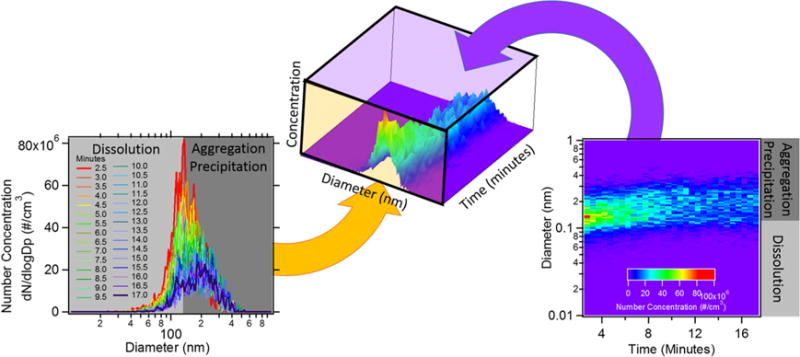
A diagram depicting (left) a series of overlaid number size distributions as a function of time and (right) a plot of time versus diameter with concentration as color. The 3-D plot (middle) shows the relationship between each plot and the benefits of time on the x-axis for monitoring dissolution and aggregation as a function of time. Arrows indicate the plane of the 3-D image being used for each plot.
Number size distributions and total particle concentrations were collected and used to create image plots (Figure 2) for each of the AgNP in each of the acidic SGF over a period of 17 min in order to evaluate the rapid change in AgNP diameter and concentration. Under highly acidic conditions (pH 2), each of the four AgNPs showed a decrease in the total particle number concentration (Supporting Information, Figure S1) and a corresponding rapid increase in particle diameter (Figure S2) over time, with these changes becoming less rapid with increasing pH. No change was observed to occur for any of the particles in the control water experiments (neutral pH) as shown in Figure S3. The image plots in Figure 2 indicate that the main changes in AgNP size and concentration, especially under high acidity conditions, occur in the initial 10 min after mixing with the SGF, with an equilibrium concentration being approached after this, which is consistent with previous studies.27,29,30 Signal intensity in the image plots, as indicated by the color scale, decreases over time from particle number concentration decreasing primarily due to agglomeration. For example, a single 100 nm aggregate of PVP 20 might have ten 20 nm particles within it, thus the number concentration will have decreased from ten to one. There are also small contributions from wall losses or sedimentation as a function of time. The 20 nm particles showed rapid growth in diameter in pH 2 SGF, with diameters reaching as large as 75 nm for the Citrate 20 and 50 nm for the PVP 20 after 2 min, compared with original diameters of 25 and 29 nm, respectively. The 110 nm particles were observed to have little growth over the initial 2 min at each of the SGF pH values.
Figure 2.
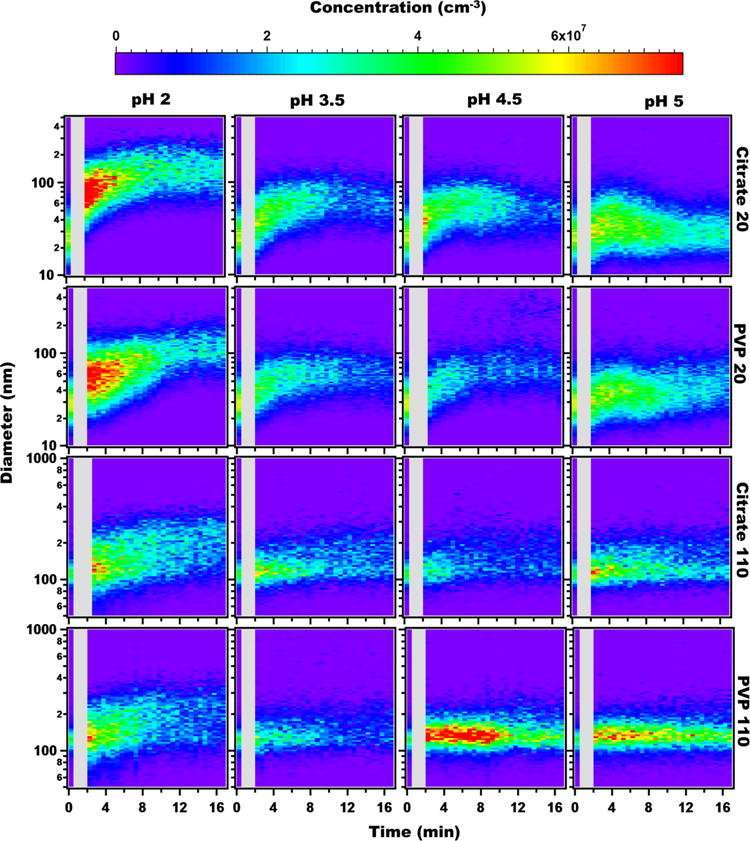
Image plots for Citrate 20, PVP 20, Citrate 110, and PVP 110 showing changes in particulate size and concentration over time for each SGF pH examined. The gray bar in each graph indicates time in which there was no sizing data.
Figure 3 shows the absolute and percent change in each of the particle diameters from their respective original diameters to their final diameter measured by the NTA after 17 min exposure to SGF at each pH. The largest growth in diameter occurred for the 20 nm particles in SGF pH 2, with the final diameters roughly 400% and 300% larger than their original diameter for Citrate 20 and PVP 20, respectively. At pH 2 and 3.5, the 20 nm particles were still roughly twice their original size. The 110 nm particles were never observed to reach double their original size at any pH, with the most growth being observed at pH 2. Additionally, these results show that the citrate particles grew more than the PVP particles. Though Peretyazhko et al.26 described similar growth in the smaller particles in acidic media, we observed a larger growth diameter up to several times that of the original diameter and under much faster time scales, within minutes instead of days to weeks.
Figure 3.
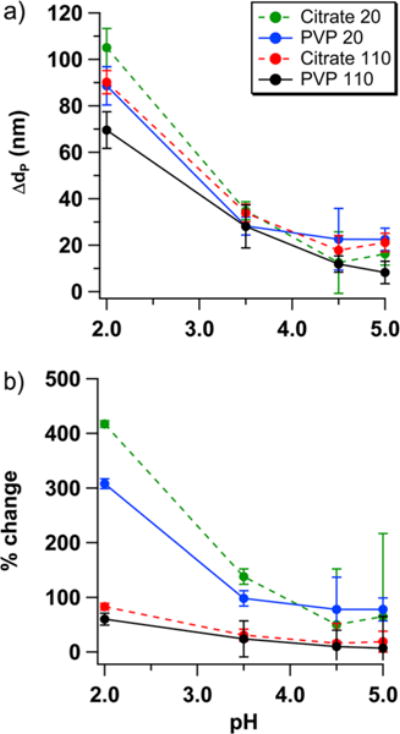
(a) Absolute and (b) percent change from original diameter at each SGF pH. Error bars are present; however, the calculated error is smaller than the width of the graph markers for some points, making the bars difficult to observe.
While in the neutral solution, the capping agents on particles such as citrate and PVP will cause AgNP to repel each other and remain as single particles in solution due to electrostatic repulsion (negatively charged surface) and steric repulsion, respectively (Figure 4). When introduced into acidic solutions such as HCl, the capping agent is stripped from the particle surface along with some Ag+ and there is metal oxide formation which can lead to hydroxylation and formation of silver oxide (AgO−) at the nanoparticle surface. It is well-known that citrate is a less stable coating than PVP in aqueous solutions,48,49 and therefore it is expected that this will be stripped more easily from the particle surface than PVP. There are two options possible for the loss of PVP coating from the AgNP: (1) PVP is completely stripped by the high acid/salt environment leaving a bare Ag0 surface that will then dissolve or (2) PVP is partially stripped leaving some PVP on the surface and some bare surface where Ag+ is released in solution and then precipitates as AgCl. Studies have also shown that when PVP is in an acidic solution it can decompose, leading to loss of capping agent from the AgNP surface.50 Therefore, based on the literature and our results we anticipate that option 1 is the dominant mechanism, but acknowledge that option 2 is possible and would be difficult to quantify given the complexity of the media. With the addition of components such as HCl and NaCl, the released Ag+ binds with excess Cl− in the solution, forming AgCl. This AgCl can then precipitate (ksp = 1.8 × 10−10) onto the surface of the AgNP, and as others have observed, create a surface in which the AgNPs would no longer repel each other,29,30 presumably due to neutral surface conditions and a lack of steric hindrance. Figure 5 shows an elemental map (inset) of two PVP 110 aggregated particles exposed to pH 2 SGF that have been mapped showing the Ag and Cl elemental composition along with the EDX spectra from the AgNP core and the precipitated AgCl coating or shell onto the surface. The EDX spectra indicate that the core of the aggregate is primarily silver from the AgNP and that the shell is primarily AgCl. This indicates that AgCl is precipitating onto the surface of the particles and facilitating aggregation. Therefore, when particles diffuse and collide in solution, they will have a van der Waal’s attraction and through collisions, aggregate.
Figure 4.
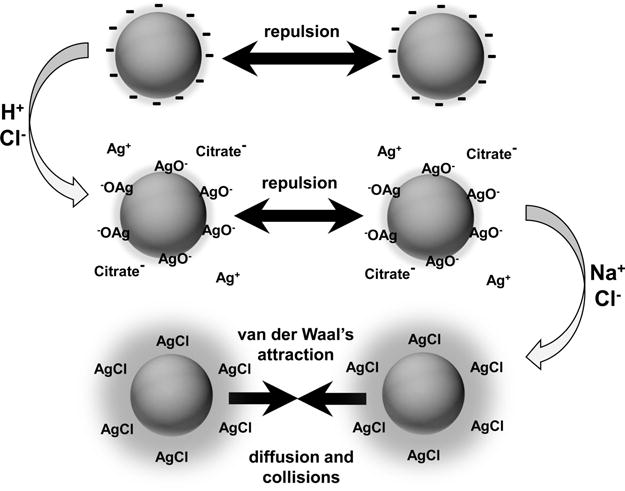
Schematic of AgNP interactions in acidic SGF media using the example of citrate which is stabilized by electrostatic repulsion. PVP would stabilize via steric hindrance but would also be stripped off in acidic solution resembling this mechanism.
Figure 5.
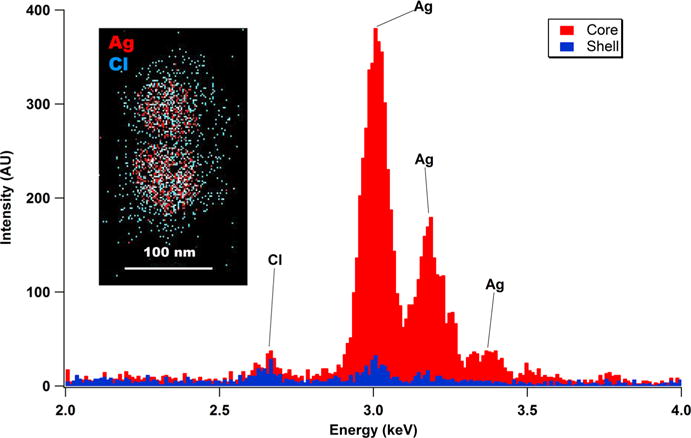
EDX spectra of the core and the precipitated AgCl coating for a PVP 110 aggregate in pH 2 SGF, along with elemental mapping of Ag (red) and Cl (aqua) in the inset.
Zeta potential was determined in order to find the isoelectric pH (pHiso), or the pH at which the surface is neutral and aggregation will occur, for each of the AgNP in solution (Figure 6). The ZP for all particles was collected in neutral water (pH 7) in the absence of any acid or salts. Results indicate that in these neutral water solutions all particles were stable with a negative ZP.36 Given the difficulty of measuring ZP due to probe damage in corrosive solutions, such as those in high salt and acidic environments, the ZP in acidic solutions was only measured for PVP 20 and PVP 110 to avoid additional impacts from citrate salt in the Citrate 20 and Citrate 110 solutions. As the pH is decreased in the PVP + HCl solutions, the ZP moves toward a more neutral surface charge, such that at pH 2 the two AgNP particle sizes are nearly neutral. This is also observed in experiments by Elzey et al.21 using bare AgNP in nitric acid (HNO3). Because the gastric environment consists of both HCl and salts, the influence of salt on particle ZP was evaluated for PVP 20 and PVP 110 in a 2 mM NaCl solution at pH 7. In this solution, the ZP increased relative to that of neutral water by a factor of 11.2 mV for PVP 20 and 13.4 mV for PVP 110. These factors were then used as a way to estimate the ZP of the PVP particles in SGF solutions by adding this factor to the ZP measured in the acidic solutions. From this it was approximated that the isoelectric pH in SGF was around pH 4.2 and pH 2.6 for PVP 20 and PVP 110 particles, respectively. This accounts for the observation that the larger 110 nm particles do not increase in diameter until pH 2 and the smaller, 20 nm particles were observed to increase in diameter even at pH 4.5. It also explains the fluctuating particle diameters observed at pH 4.5 and 5 for 20 nm particles (Figure 2), as the solution was approaching the isoelectric point and becoming less stable.
Figure 6.
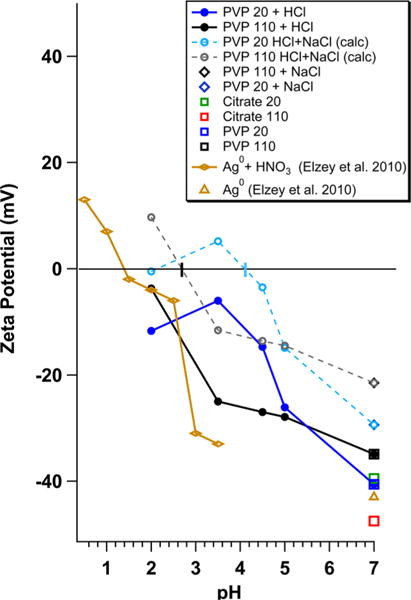
ZP of capped AgNP in acidic, neutral, and salt solutions and bare19 AgNP in acidic and neutral solutions to determine their isoelectric pH (ZP = 0). Theoretical ZP measurements for PVP 20 and PVP 110 nm particles in SGF (particle + HCl + NaCl) were calculated to provide isoelectric pHs of PVP 20 and PVP 110 in SGF (solid marks at zero line). Solid lines and markers are experimental data, while dashed lines are theoretical.
Reaction rates were determined from the changes in particle diameter and number concentration over time (Figure 7). For the purpose of comparison between each of the particles, the linear rate of change in the particle number concentration (particle loss rate) and diameter (particle growth rate) under the various SGF conditions was determined for the initial 10 min of exposure to SGF, the period of time observed to have the greatest particulate changes for all AgNP. The relative particle loss rate (by number) was observed to be size dependent such that Citrate 20 = PVP 20 > Citrate 110 > PVP 110. As the stomach moves from a fasted to a fed state (decreasing acidity), the particle loss rate of the AgNP was observed to slow for each of the AgNPs. These results were expected due to surface to volume ratios of the two AgNP sizes and the Ostwald–Freundlich relation for size-dependent dissolution, which was determined for initial particle sizes for all AgNP particles (Figure S4).
Figure 7.
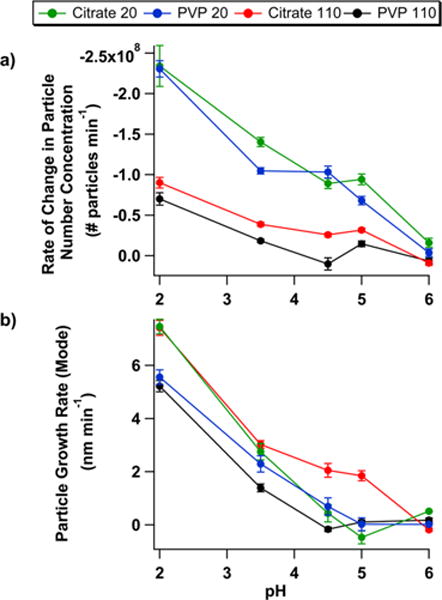
Particle (a) loss and (b) growth rates for each AgNP in varying SGF pH and in water (pH 6). The negative sign of the particle loss rates indicate loss of nanoparticles.
Unlike the particle loss rate, the particle diameter growth rate as a function of pH appears to be primarily influenced by the particle capping agent (Figure 7). The particle growth rate for each of the 20 nm particles, however, was observed to shift from second-order to first-order with increasing pH, whereas it was always observed to be first-order with the 110 nm particles. The particle growth rate was observed to be dependent upon AgNP capping agent and size such that Citrate 20 = Citrate 110 > PVP 20 > PVP 110, with the particle growth rate slowing for all AgNP as the pH was increased. Citrate 20 showed the greatest growth rate over the 10 min period accompanied by the greatest loss in particulate concentration at pH 2. PVP 20 showed a lower growth rate at pH 2 when compared to the Citrate 20, but their particle loss rates were similar. This may be due to slower growth as a factor of the capping agent. At pH 2, Citrate 110 showed a greater growth rate than PVP 110, though with the same particle loss rate, again postulated to be due to the capping agent, as with the 20 nm particles. The 110 nm particles appeared be growing concurrently with particles being lost, suggesting that what was lost initially was added subsequently in growth. This was not the same for the 20 nm particles, which showed a decrease in particle number concentration without subsequent particle growth with increasing pH. The formation of AgCl is dependent upon the release of Ag+ from the AgNP surface, which will vary in concentration due to solution acidity, such that increasing acidity will cause decreasing production of Ag+. Therefore, there may not be great enough AgCl concentration for precipitation onto particles leading to aggregation.
Our growth rates were compared to those of a previous aggregation kinetics study using a calculated lumped aggregation rate constant of AgNP, using the Smoluchowski model (Figure S5).27,51–53 Results show that under different ionic conditions (i.e., Cl− vs NO3−) the AgNP will aggregate at a much faster rate in HCl and NaCl solution than in HNO3, which is significant since HCl and NaCl are more relevant media to the human GI tract. This indicates the acidic media will have a large impact on the colloidal formation of AgNP aggregates and therefore impact the colloidal formation of AgNP in the presence of biological material, particularly when exposed to conditions that could be present in the human GI tract. Our study finds that Ag+ is removed to a greater extent in acidic media, in agreement with Tai et al.,27 and that this dissolution is enhanced with decreasing AgNP size. Expanding this to more relevant biological conditions, with relevant NaCl concentrations in SGF, aggregation is enhanced further by the precipitation of insoluble AgCl in the presence of excess Cl−.
The total particulate mass, assumed to be metallic silver (Agmetal) and precipitated silver chloride (AgCl) on the AgNP surfaces, was calculated from each of the number size distributions by converting the number of particles at each size, assuming perfect spheres, into a volume distribution, which was then multiplied by the density of metallic silver (10.5 g cm−3) to obtain mass (assuming that mass Agmetal ≫ AgCl). The total mass was summed over each of the size distributions and monitored over time for each particle size and coating (Figure S6). The estimated total particulate mass is observed to increase for PVP 20 at pH 2 and at pH 4.5. The particle growth at pH 2 for PVP 20 may be due to particles taking on mass from the surrounding SGF in the form of AgCl precipitating on the particles due to its low solubility and pulling Cl− out of solution in the precipitate, which aids in agglomeration. In pH > 3.5 SGF, the 20 nm particles appear to have stable mass, which is consistent with less Ag+ being generated under the less acidic conditions which then incorporates previously dissolved Cl− in the AgCl precipitate. The larger, 110 nm particles appear stable in total mass over the entire time period for each pH tested. This indicates less particle loss at pH 2 for 110 nm AgNP (both coatings) than for the 20 nm AgNP, which is consistent with literature showing that smaller sized nanoparticles of the same material have higher dissolution rates.21 The total mass for the individual AgNP was relatively stable over the evaluated time period, indicating that the particles may be growing in size via aggregation, or having a comparable amount of AgCl precipitate as was initially dissolved.
Representative TEM and SEM images were collected for each type of AgNP in pH 2 and pH 5 to examine particle morphology and aggregation, along with TEM/EDX elemental mapping showing elemental distribution on particles exposed to SGF pH 2 (Figure 8). The images show the AgNP aggregate in the lower pH solutions and mainly appear as single particles in the higher pH solutions. Elemental mapping of the particles indicates that AgCl is in fact depositing on the surface and located between the aggregates. Owing to drying of these particles under the high vacuum conditions used in electron microscopy, there is the possibility that modifications occurred due to the drying process. Additionally, Citrate 110 and PVP 110 particles in pH 5 appear to have irregular surfaces, which is believed to be due deposition of AgCl to the surface as indicated by the elemental mapping.
Figure 8.
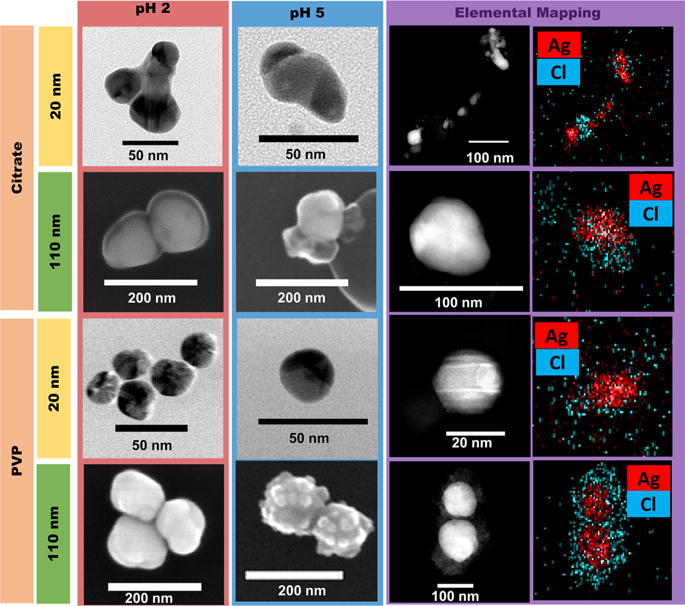
TEM images of 20 nm (yellow) AgNP and SEM images of 110 nm (green) AgNP after being digested in SGF of pH 2 (red) and pH 5 (blue) for a period of 10 min. Elemental mapping (right) using TEM/EDX (purple) shows the distribution of these elements on the particles.
On the basis of these data and that of previous studies,29,30 we postulate that there are multiple processes occurring on rapid time scales (0–10 min) with the AgNP in the SGF solutions under highly acidic pH conditions (<3.5) and lower acidity conditions. Figure 9 shows a schematic of the predicted relative concentrations of different forms of silver based on our model developed from the data above. This uses kinetics observed from the different pH studies: individual particles (AgNP0), free ionic (Ag+), precipitated (AgCl), and aggregated (AgNPagg) silver acidic stomach fluid during the first 10 min after ingestion. The data suggest that, initially, the number concentration of ingested single AgNPs under acidic condition will decrease due to surface dissolution generating free Ag+. Chloride present in the stomach will then interact with the Ag+ precipitating as AgCl. This AgCl is essentially insoluble and has been previously observed to bond to silver surfaces and facilitate in AgNP aggregation.30 The smaller 20 nm particles have a greater surface to volume ratio, which may be why they showed a greater growth due to the loss of surface Ag+ which would precipitate as AgCl on the surface of particles and facilitate aggregation, thus the higher growth rates observed.
Figure 9.
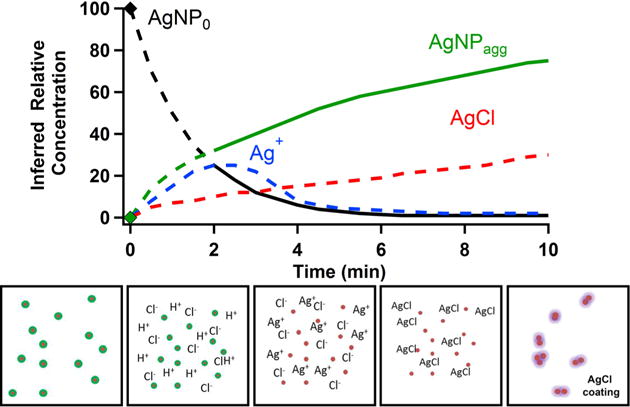
Cartoon schematic of the predicted processing of AgNP in the human stomach using Citrate 20 in pH < 2 during the first 10 min after ingestion as an example. The forms of silver include initial single AgNPs (AgNP0), free Ag+ ions, AgCl precipitate, and aggregated particulates (AgNPagg). Initial data (markers) and data for AgNP0 and AgNPagg are solid lines. Inferred data for Ag+, AgCl, and time 0.1–2 min for AgNP0 and AgNPagg are shown as dashed lines.
CONCLUSIONS
Results from this study show that the size and capping agent of AgNP play a role in particle growth and loss kinetics in simulated gastrointestinal fluid of different acidities representing fasted to fed states of the stomach. Under highly acidic conditions (pH 2) there was an observed difference in the particle growth rate due to the surface capping agent, whereas the particle number concentration was dependent on particle size. Faster rates of change of particle number concentration observed for the 20 nm particles indicate size-dependent particle loss consistent with previous studies.20 These changes in particle size and concentration were rapid at lower pH and observed to decrease in rate as the pH was increased. At high salt concentrations, it is believed that the AgCl dominates, such that the hydroxylated surface is no longer a factor in the acidic solutions and that AgCl precipitation effectively neutralizes the surface of the particles. This leads to aggregation after collisions and no repulsive effects to overcome van der Waals attractive forces. It is hypothesized that the greater particle loss rate of smaller particles led to an increase in Ag+ concentration in solution and consequently greater AgCl precipitation, increasing the size of the suspended particles by facilitating aggregation. Additionally, the 20 nm particles in solutions > pH 3.5 showed a decrease in particle concentration without subsequent particle growth with increasing pH, which may be due to less H+ available to release Ag+ and form AgCl from aggregation. This leads us to revise the current multistep dissolution and aggregation mechanism of AgNP in SGF such that first Ag+ formation occurs, followed by the precipitation of AgCl and aggregation of AgNP.
Future studies will investigate an array of acidic and basic conditions representing stomach and intestinal fluid both with and without the presence of proteins. The present work simulated the gastric compartment only and under conditions in the body, particles exiting the gastric compartment will encounter yet a different chemical and physical environment in the small intestine (more neutral pH, more diverse enzymatic activity), which may impact the protein corona. Thus, understanding the particle state as they exit the stomach is the first step, but future work may need to explain what happens to those particles in the intestinal environment.
Companion papers showing the biological relevance of ingested AgNP in mice shows no immediate toxicological effect on mice, no effects on indigenous gut microbes, and that much of the silver is recovered in the mice excrement.36 This along with the current study implies that there are limited opportunities for Ag+ of the AgNP to interact with gut lining epithelium or with luminal bacteria, because it will form AgCl within the salt and acidic conditions of the human stomach. Thus, by improving our understanding of silver nanoparticle physical processes and evolution, fundamental understanding can be obtained regarding observed biological responses to AgNPs.
Supplementary Material
Acknowledgments
This project was supported through NIH Grant U01ES020128. D.I.S. was supported through the NIEHS department T32ES007062 training grant. Silver nanomaterials used in this study were procured, characterized, and provided to investigators by NIEHS Centers for Nanotechnology Health Implications Research (NCNHIR) Consortium. The NIEHS Centers for Nanotechnology Health Implications Research (NCNHIR) was established with the centers funded by RFA ES-09-011. These centers formed a consortium with other NIEHS funded researchers and other federal laboratories in the area of Nano EHS and worked together on a select set of engineered nanomaterials provided to the consortium by NIEHS. Any opinions, findings, conclusions, or recommendations expressed herein are those of the author(s) and do not necessarily reflect the views of the National Institute of Environmental Health Sciences/NIH. The authors would like to thank Greg Amidon at the University of Michigan Pharmacy School for helpful discussions of SGF. The authors would like to thank Justin Keeney for his help in collection of the zeta potential. Dr. Pamela Wong of the Department of Biological Chemistry at the University of Michigan Medical School under Prof. Ari Gafini is acknowledged for the use of the DLS instrument. The staff of the Electron Microbeam Analysis Laboratory (EMAL) at the University of Michigan is acknowledged for assistance with electron microscopy.
Footnotes
Supporting Information
The Supporting Information is available free of charge on the ACS Publications website at DOI: 10.1021/acs.jpcc.5b03634.
Characterization of all AgNPs, particle size, and concentration measurements using NTA, size dependent dissolution Ostwald–Freundlich calculations, the comparison of aggregation kinetics with previous literature, and AgNP mass calculations (PDF).
Notes
The authors declare no competing financial interest.
References
- 1.Chaudhry Q, Scotter M, Blackburn J, Ross B, Boxall A, Castle L, Aitken R, Watkins R. Applications and implications of nanotechnologies for the food sector. Food Addit Contam, Part A. 2008;25:241–258. doi: 10.1080/02652030701744538. [DOI] [PubMed] [Google Scholar]
- 2.Mitrano DM, Rimmele E, Wichser A, Erni R, Height M, Nowack B. Presence of nanoparticles in wash water from conventional silver and nano-silver textiles. ACS Nano. 2014;8:7208–7219. doi: 10.1021/nn502228w. [DOI] [PubMed] [Google Scholar]
- 3.Varner KE, El-Badawy A, Feldhake D, Venkatapathy R. State-of-the-science review: Everything nanosilver and more. U.S. Environmental Protection Agency; Washington, DC: 2010. (EPA/600/R-10/084). [Google Scholar]
- 4.Teow Y, Asharani PV, Hande MP, Valiyaveettil S. Health impact and safety of engineered nanomaterials. Chem Commun. 2011;47:7025–7038. doi: 10.1039/c0cc05271j. [DOI] [PubMed] [Google Scholar]
- 5.Gottschalk F, Nowack B. The release of engineered nanomaterials to the environment. J Environ Monit. 2011;13:1145–1155. doi: 10.1039/c0em00547a. [DOI] [PubMed] [Google Scholar]
- 6.Chaloupka K, Malam Y, Seifalian AM. Nanosilver as a new generation of nanoproduct in biomedical applications. Trends Biotechnol. 2010;28:580–588. doi: 10.1016/j.tibtech.2010.07.006. [DOI] [PubMed] [Google Scholar]
- 7.Mudunkotuwa IA, Grassian VH. The devil is in the details (or the surface): Impact of surface structure and surface energetics on understanding the behavior of nanomaterials in the environment. J Environ Monit. 2011;13:1135–1144. doi: 10.1039/c1em00002k. [DOI] [PubMed] [Google Scholar]
- 8.Reidy B, Haase A, Luch A, Dawson KA, Lynch I. Mechanisms of silver nanoparticle release, transformation and toxicity: A critical review of current knowledge and recommendations for future studies and applications. Materials. 2013;6:2295–2350. doi: 10.3390/ma6062295. [DOI] [PMC free article] [PubMed] [Google Scholar]
- 9.Hadrup N, Lam HR. Oral toxicity of silver ions, silver nanoparticles and colloidal silver – A review. Regul Toxicol Pharmacol. 2014;68:1–7. doi: 10.1016/j.yrtph.2013.11.002. [DOI] [PubMed] [Google Scholar]
- 10.Nowack B, Krug HF, Height M. 120 years of nanosilver history: Implications for policy makers. Environ Sci Technol. 2011;45:1177–1183. doi: 10.1021/es103316q. [DOI] [PubMed] [Google Scholar]
- 11.Maynard AD, Warheit DB, Philbert MA. The new toxicology of sophisticated materials: Nanotoxicology and beyond. Toxicol Sci. 2011;120:S109–S129. doi: 10.1093/toxsci/kfq372. [DOI] [PMC free article] [PubMed] [Google Scholar]
- 12.Bergin IL, Witzmann FA. Nanoparticle toxicity by the gastrointestinal route: evidence and knowledge gaps. Int J Biomed Nanosci Nanotechnol. 2013;3:163–210. doi: 10.1504/IJBNN.2013.054515. [DOI] [PMC free article] [PubMed] [Google Scholar]
- 13.Liu JY, Hurt RH. Ion Release Kinetics and particle persistence in aqueous nano-silver colloids. Environ Sci Technol. 2010;44:2169–2175. doi: 10.1021/es9035557. [DOI] [PubMed] [Google Scholar]
- 14.Stebounova LV, Guio E, Grassian VH. Silver nanoparticles in simulated biological media: A study of aggregation, sedimentation, and dissolution. J Nanopart Res. 2011;13:233–244. [Google Scholar]
- 15.Liu JY, Sonshine DA, Shervani S, Hurt RH. Controlled release of biologically active silver from nanosilver surfaces. ACS Nano. 2010;4:6903–6913. doi: 10.1021/nn102272n. [DOI] [PMC free article] [PubMed] [Google Scholar]
- 16.Lowry GV, Espinasse BP, Badireddy AR, Richardson CJ, Reinsch BC, Bryant LD, Bone AJ, Deonarine A, Chae S, Therezien M, et al. Long-term transformation and fate of manufactured Ag nanoparticles in a simulated large scale freshwater emergent wetland. Environ Sci Technol. 2012;46:7027–7036. doi: 10.1021/es204608d. [DOI] [PubMed] [Google Scholar]
- 17.Li X, Lenhart JJ. Aggregation and dissolution of silver nanoparticles in natural surface water. Environ Sci Technol. 2012;46:5378–5386. doi: 10.1021/es204531y. [DOI] [PubMed] [Google Scholar]
- 18.Nutzenadel C, Zuttell A, Chartouni D, Schmid G, Schlapbach L. Critical size and surface effect of the hydrogen interaction of palladium clusters. Eur Phys J D. 2000;8:245–250. [Google Scholar]
- 19.Misra SK, Dybowska A, Berhanu D, Luoma SN, Valsami-Jones E. The complexity of nanoparticle dissolution and its importance in nanotoxicological studies. Sci Total Environ. 2012;438:225–232. doi: 10.1016/j.scitotenv.2012.08.066. [DOI] [PubMed] [Google Scholar]
- 20.Ma R, Levard C, Marinakos SM, Cheng Y, Liu J, Michel FM, Brown GE, Lowry GV. Size-controlled dissolution of organic-coated silver nanoparticles. Environ Sci Technol. 2012;46:752–759. doi: 10.1021/es201686j. [DOI] [PubMed] [Google Scholar]
- 21.Elzey S, Grassian VH. Agglomeration, isolation and dissolution of commercially manufactured silver nanoparticles in aqueous environments. J Nanopart Res. 2010;12:1945–1958. [Google Scholar]
- 22.Wang X, Ji Z, Chang CH, Zhang H, Wang M, Liao Y-P, Lin S, Meng H, Li R, Sun B, et al. Use of coated silver nanoparticles to understand the relationship of particle dissolution and bioavailability to cell and lung toxicological potential. Small. 2014;10:385–398. doi: 10.1002/smll.201301597. [DOI] [PMC free article] [PubMed] [Google Scholar]
- 23.Ding F, Radic S, Chen R, Chen PY, Geitner NK, Brown JM, Ke PC. Direct observation of a single nanoparticle-ubiquitin corona formation. Nanoscale. 2013;5:9162–9169. doi: 10.1039/c3nr02147e. [DOI] [PMC free article] [PubMed] [Google Scholar]
- 24.Podila R, Chen R, Ke PC, Brown JM, Rao AM. Effects of surface functional groups on the formation of nanoparticle-protein corona. Appl Phys Lett. 2012 doi: 10.1.26370110.1063/1.4772509. [DOI] [PMC free article] [PubMed] [Google Scholar]
- 25.Lynch I, Cedervall T, Lundqvist M, Cabaleiro-Lago C, Linse S, Dawson KA. The nanoparticle – protein complex as a biological entity; a complex fluids and surface science challenge for the 21st century. Adv Colloid Interface Sci. 2007:134–35. doi: 10.1016/j.cis.2007.04.021. [DOI] [PubMed] [Google Scholar]
- 26.Peretyazhko TS, Zhang QB, Colvin VL. Size-controlled dissolution of silver nanoparticles at neutral and acidic pH conditions: Kinetics and size changes. Environ Sci Technol. 2014;48:11954–11961. doi: 10.1021/es5023202. [DOI] [PubMed] [Google Scholar]
- 27.Tai J-T, Lai C-S, Ho H-C, Yeh Y-S, Wang H-F, Ho R-M, Tsai D-H. Protein silver nanoparticle interactions to colloidal stability in acidic environments. Langmuir. 2014;30:12755–12764. doi: 10.1021/la5033465. [DOI] [PubMed] [Google Scholar]
- 28.El Badawy AM, Luxton TP, Silva RG, Scheckel KG, Suidan MT, Tolaymat TM. Impact of environmental conditions (pH, ionic strength, and electrolyte type) on the surface charge and aggregation of silver nanoparticles suspensions. Environ Sci Technol. 2010;44:1260–1266. doi: 10.1021/es902240k. [DOI] [PubMed] [Google Scholar]
- 29.Mwilu SK, El Badawy AM, Bradham K, Nelson C, Thomas D, Scheckel KG, Tolaymat T, Ma LZ, Rogers KR. Changes in silver nanoparticles exposed to human synthetic stomach fluid: Effects of particle size and surface chemistry. Sci Total Environ. 2013;447:90–98. doi: 10.1016/j.scitotenv.2012.12.036. [DOI] [PubMed] [Google Scholar]
- 30.Rogers KR, Bradham K, Tolaymat T, Thomas DJ, Hartmann T, Ma LZ, Williams A. Alterations in physical state of silver nanoparticles exposed to synthetic human stomach fluid. Sci Total Environ. 2012;420:334–339. doi: 10.1016/j.scitotenv.2012.01.044. [DOI] [PubMed] [Google Scholar]
- 31.Walczak AP, Fokkink R, Peters R, Tromp P, Rivera ZEH, Rietjens I, Hendriksen PJM, Bouwmeester H. Behaviour of silver nanoparticles and silver ions in an in vitro human gastrointestinal digestion model. Nanotoxicology. 2013;7:1198–1210. doi: 10.3109/17435390.2012.726382. [DOI] [PubMed] [Google Scholar]
- 32.Iggland M, Mazzotti M. Population balance modeling with size-dependent solubility: ostwald ripening. Cryst Growth Des. 2012;12:1489–1500. [Google Scholar]
- 33.Jang E, Lim EK, Choi J, Park J, Huh YJ, Suh JS, Huh YM, Haam S. Br-assisted ostwald ripening of Au nanoparticles under H2O2 redox. Cryst Growth Des. 2012;12:37–39. [Google Scholar]
- 34.Liu JY, Wang ZY, Liu FD, Kane AB, Hurt RH. Chemical transformations of nanosilver in biological environments. ACS Nano. 2012;6:9887–9899. doi: 10.1021/nn303449n. [DOI] [PMC free article] [PubMed] [Google Scholar]
- 35.Kent RD, Vikesland PJ. Controlled evaluation of silver nanoparticle dissolution using atomic force microscopy. Environ Sci Technol. 2012;46:6977–6984. doi: 10.1021/es203475a. [DOI] [PubMed] [Google Scholar]
- 36.Bergin IL, Wilding LA, Morishita M, Walacavage K, Ault AP, Axson JL, Start DI, Hashway SA, Capracotta SS, Lerouell PR, et al. Effects of particle size and coating on toxicologic parameters, fecal elimination kinetics and tissue distribution of acutely ingested silver nanoparticles in a mouse model. Nanotoxicology. 2015 doi: 10.3109/17435390.2015.1072588. in press. [DOI] [PMC free article] [PubMed] [Google Scholar]
- 37.Mudie DM, Amidon GL, Amidon GE. Physiological parameters for oral delivery and in vitro testing. Mol Pharmaceutics. 2010;7:1388–1405. doi: 10.1021/mp100149j. [DOI] [PMC free article] [PubMed] [Google Scholar]
- 38.Kalantzi L, Goumas K, Kalioras V, Abrahamsson B, Dressman JB, Reppas C. Characterization of the human upper gastrointestinal contents under conditions simulating bioavailability/bioequivalence studies. Pharm Res. 2006;23:165–176. doi: 10.1007/s11095-005-8476-1. [DOI] [PubMed] [Google Scholar]
- 39.Jantratid E, De Maio V, Ronda E, Mattavelli V, Vertzoni M, Dressman JB. Application of biorelevant dissolution tests to the prediction of in vivo performance of diclofenac sodium from an oral modified-release pellet dosage form. Eur J Pharm Sci. 2009;37:434–441. doi: 10.1016/j.ejps.2009.03.015. [DOI] [PubMed] [Google Scholar]
- 40.Hollebeeck S, Borlon F, Schneider YJ, Larondelle Y, Rogez H. Development of a standardised human in vitro digestion protocol based on macronutrient digestion using response surface methodology. Food Chem. 2013;138:1936–1944. doi: 10.1016/j.foodchem.2012.11.041. [DOI] [PubMed] [Google Scholar]
- 41.Versantvoort CHM, Oomen AG, Van de Kamp E, Rompelberg CJM, Sips AJAM. Applicability of an in vitro digestion model in assessing the bioaccessibility of mycotoxins from food. Food Chem Toxicol. 2005;43:31–40. doi: 10.1016/j.fct.2004.08.007. [DOI] [PubMed] [Google Scholar]
- 42.USP. The Pharmacopeia of the United States of America XVI. Mack Publishing Company, Easton; 1960. [Google Scholar]
- 43.Axson JL, Creamean JM, Bondy AL, Capracotta SS, Warner KY, Ault AP. An In situ method for sizing insoluble residues in precipitation and other aqueous samples. Aerosol Sci Technol. 2015;49:24–34. doi: 10.1080/02786826.2014.991439. [DOI] [PMC free article] [PubMed] [Google Scholar]
- 44.Carr B, Wright M. Nanoparticle Tracking Analysis: A Review of Applications and Usage, 2010–2012. NanoSight Ltd; Minton Park, London Road, Amesbury, Wiltshire, SP4 7RT: 2013. p. 193. [Google Scholar]
- 45.Filipe V, Hawe A, Jiskoot W. Critical evaluation of nanoparticle tracking analysis (NTA) by NanoSight for the measurement of nanoparticles and protein aggregates. Pharm Res. 2010;27:796–810. doi: 10.1007/s11095-010-0073-2. [DOI] [PMC free article] [PubMed] [Google Scholar]
- 46.Kramberger P, Ciringer M, Strancar A, Peterka M. Evaluation of nanoparticle tracking analysis for total virus particle determination. Virol J. 2012;9:1–10. doi: 10.1186/1743-422X-9-265. [DOI] [PMC free article] [PubMed] [Google Scholar]
- 47.Malloy A. Count, size and visualize nanoparticles. Mater Today. 2011;14:170–173. [Google Scholar]
- 48.Tejamaya M, Roemer I, Merrifield RC, Lead JR. Stability of citrate, PVP, and PEG coated silver nanoparticles in ecotoxicology media. Environ Sci Technol. 2012;46:7011–7017. doi: 10.1021/es2038596. [DOI] [PubMed] [Google Scholar]
- 49.Huynh KA, Chen KL. Aggregation Kinetics of Citrate and polyvinylpyrrolidone coated silver nanoparticles in monovalent and divalent electrolyte solutions. Environ Sci Technol. 2011;45:5564–5571. doi: 10.1021/es200157h. [DOI] [PMC free article] [PubMed] [Google Scholar]
- 50.Breitenbach JW. Polymerization and polymners of N-vinylpyrrolidone. J Polym Sci. 1957;23:949–953. [Google Scholar]
- 51.Tsai DH, Pease LF, Zangmeister RA, Tarlov MJ, Zachariah MR. Aggregation kinetics of colloidal particles measured by gas-phase differential mobility analysis. Langmuir. 2009;25:140–146. doi: 10.1021/la703164j. [DOI] [PubMed] [Google Scholar]
- 52.Russel WB, Saville DA, Schowalter WR. Colloidal Dispersions. Cambridge University Press; Cambridge, UK: 1989. [Google Scholar]
- 53.Hinds WC. Aerosol Technology: Properties, Behavior, And Measurements of Airborne Particles. 2nd. John Wiley & Sons; New York: 1999. [Google Scholar]
Associated Data
This section collects any data citations, data availability statements, or supplementary materials included in this article.


